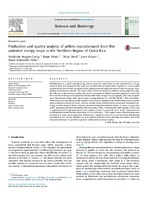Production and quality analysis of pellets manufactured from five potential energy crops in the Northern Region of Costa Rica

Date
2016Author
Aragón-Garita, Stephanie
Moya-Roque, Róger
Bond, Brian
Valaert, Jorre
Tomazello-Filho, Mario
Metadata
Show full item recordAbstract
Modifications to a pellet manufacturing process must be made based on the characteristics of raw
material used. The purpose of this work was to determine the alternations required to a wood pellet
manufacturing process and the quality of the pellets produced using this process from five energy crops.
Quality measurements include: the caloric value, the loss of moisture content in each production stage,
the efficiency index of particle-pellet, ash content and quality as defined using the quantity of cracks and
the transversal density and longitudinal density determined using X-ray radiography. The crops analyzed
were rhizomatous plants, with caloric values ranging between 17.1 and 20.3 MJ kg 1. This work determined
that it was possible to produce pellets with Gynerium sagittatum and Phyllostachys aurea using the
same production process for wood; however, Arundo donax and Pennisetum purpureum needed pre-airdrying
and the Sorghum bicolor required mechanical dewatering before drying. A. donax, P. purpureum
and G. sagittatum provided the highest efficiency index. When evaluating the pellet quality P. aurea and
G. sagittatum hard a large quantity of cracks, unlike A. donax, P. purpureum and S. bicolor. The transversal
and longitudinal pellet density varied from 1129 to 1294 kg m 3. The highest values of bulk density were
obtained in A. donax and P. purpureum, followed by G. sagittatum and P. aurea, and the lowest bulk density
was obtained in S. bicolor. Althogh out, some species produced cracks and high ash content, this work
demonstrated that it is possible to produce pellets with moderate quality.
Description
Artículo científico
Source
Biomass and BioenergyShare
Metrics
Collections
- Artículos [37]

